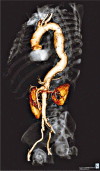Open repair of descending thoracic aneurysms
- PMID: 23440685
- PMCID: PMC3484579
Open repair of descending thoracic aneurysms
Abstract
Introduction: Current strategies for operative treatment of a thoracic aortic aneurysm consist of open repair with surgical graft replacement or endovascular exclusion. To reduce mortality and morbidity of open repair, a multimodal approach has gradually evolved by maximizing organ protection.
Methods: On a total of 1108 patients treated in our Center from 1993 for pathology involving the thoracic aorta, we reviewed the prospectively collected data of 194 consecutive patients who underwent open thoracic aortic aneurysm repair, 104 (54%) for degenerative aneurysms, 65 (34%) for dissections, 25 (12%) for other pattern of disease. Left Heart Bypass was used in 82% of cases, clamp and sew technique in 16%, hypotermic circulatory arrest in 2%.
Results: Overall perioperative mortality was 4.1%. The rate of pulmonary complications was 8.8%. The rate of cardiac complications, i.e. new onset myocardial necrosis demonstrated by positive blood tests, was 6.2%. The rate of renal complications was 7.2%. Cerebrovascular accident, defined as a new neurologic deficit lasting more than 24 hours confirmed by imaging, occurred in 2.0% of patients. The rate of spinal cord ischemia, manifesting either as paraplegia or paraparesis, was 4.6%.
Conclusions: Mortality and morbidity rates of open thoracic aortic aneurysm repair are currently satisfactory especially in fit patients. In order to define surgical indications and the role of endovascular repair, consideration of age of the patient, comorbidity, symptoms, life expectancy, likely quality of life (if asymptomatic), aortic diameter, aneurysm morphology, aneurysm extent, suitability of landing zones, and operator experience are all distinctly relevant.
Keywords: Marfan syndrome; aortic surgical graft; open aortic repair; thoracic aortic aneurysm; thoracic aortic dissection; type B aortic dissection.
Conflict of interest statement
Figures











References
-
- Clouse WD, Hallett JW Jr, Schaff HV. et al. Improved prognosis of thoracic aortic aneurysms: a population-based study. JAMA. 1998;280:1926–1929. - PubMed
-
- Svensson LG, Kouchoukos NT, Miller DC. et al. Expert consensus document on the treatment of descending thoracic aortic disease using endovascular stent-grafts. Ann Thorac Surg. 2008;85:S1–S41. - PubMed
-
- Erbel R, Alfonso F, Boileau C. et al. Diagnosis and management of aortic dissection. Eur Heart J. 2001;22:1642–1681. - PubMed
-
- Coselli JS. Panel discussion: session III-natural history and dissection. Ann Thorac Surg. 2007;83:S84–6850.
-
- Kieffer E, Chiche L, Cluzel P. et al. Open surgical repair of descending thoracic aortic aneurysms in the endovascular era: a 9-year single-center study. Ann Vasc Surg. 2009;23:60–66. - PubMed
LinkOut - more resources
Full Text Sources
